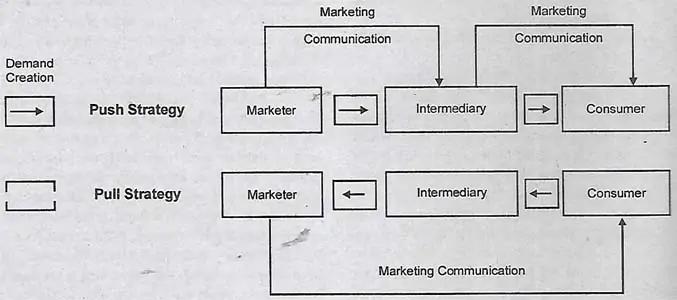Discuss Pull and Push Strategies of Communication or Promotion.
There are two strategies of promotion or communication:
- Push strategy.
- Pull strategy.
Push Strategy:
When promotion is directed at middlemen, it is known as push strategy. Under this strategy, product is pushed into the middlemen by carrying trade promotion through field staff. Trade promotion may include quantity, discounts, rebates, gifts, etc. These promotional activities encourage intermediaries to push more merchandise. Thus, it primarily aims at benefiting the manufacturer and retailer through increased sales.
However, this strategy has slow impact on the demand creation particularly for consumables and consumer goods. Thus, Sylvania & Laxman can sell its industrial fans, lites through this strategy. But selling fans for homes by following the push strategy might be undesirable because of intense competition by Crompton Greaves, Usha, Bajaj, etc.
Pull Strategy:
When promotion is directed at end-users (consumers) it is known as pull strategy. The strategy aims at the end users through advertising and sales promotions (samples, coupons, economy packs, freebies, etc.). These also include sponsorships (Pepsi the Cricket Independence Cup, Videocon-4th National Games).
The promotional strategy persuades the customer to ask intermediaries to provide them with a particular product. The strategy is so fast that the moment advertisement comes up in National Television, customer is expected to move for acquiring any consumable product.
Thus, the strategy requires distribution channels to keep the product before advertisement reaches the prospect. For example, when Volform ( a sauce from Voltas) was advertised on television, the product was not available at retail shelves. However, when the manufacturer reinforced the distribution, there was no advertisement to inform the customer that the product was available. The product failed because of poor marketing strategy.
Following figure shows the features of push and pull strategy:

For example, pollution masks were available in Delhi roads at red lights for Rs. 25 because it was pushed through the distribution system. However, it was a marketing failure because the concept of using pollution masks for controlling pollution and help the consumer and society was not put across to consumer by advertising.
The comparison of pull and push strategies:
Push Strategy:
- Target Group: Distributors, Wholesalers & Retailers.
- Purpose: Product selling.
- Primary Product Suitability: Industrial goods, Consumer Durables.
- Product Availability to Consumer: Already Available.
- Advertisement: Specific Magazines like Trade Journals.
- Sales Promotion: Dealer Contests, Trade Rebates, Discounts, Vacations, Gifts
- Personal Selling: Meeting Dealers for Sales Calls.
- Speed of Promotion for Demand Creation: Slow.
Pull Strategy:
- Target Group: End-users
- Purpose: Demand creation.
- Primary Product Suitability: Consumer Durables, consumer Goods
- Product Availability to Consumer: Needs Reinforcement else product failure.
- Advertisement: TV, Newspaper, Radio, Target Magazines
- Sales Promotion: Discount coupons, Economy packs, Contests, Samples.
- Personal Selling: Meeting consumers for Sales Calls.
- Speed of Promotion for Demand Creation: Fast.
A combination strategy is more useful than the isolated effort to carry on entire push or pull strategy. By aiming at the two, the marketer aims at benefiting that resellers and attracting the consumer.
Thus, a push strategy is used for trade promotions and personal selling which precedes the pull strategy, i.e., the consumer demand has already been created. For example, Pepsi-co heavily advertises for its brands Pepsi, Mirinda, Teem and uses sales promotion by organizing contests, events to launch product, coupons collection, etc.
Thus, demand for the product is created. Then, the Pepsi-co uses trade promotion by providing refrigerators and neon sign boards at concessional rates to the trader-retailers so that not only resellers push the products (Mirinda, Pepsi, Teem) but also consumer asks for them.



